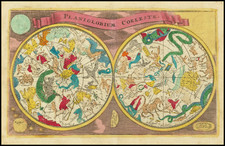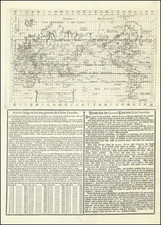Apollo Translunar / Transearth Trajectory Plotting Chart represents a highly significant object from the era of human space exploration, detailing the lunar mission profile for the historic Apollo 11 mission planned for July and August 1969. Prepared under the direction of the Department of Defense by the Aeronautical Chart and Information Center for NASA's Manned Spacecraft Center, Mapping Sciences Laboratory, this chart provides a polar view of the entire journey, from launch to touchdown, including potential mid-course corrections and specific landing sites.
Reflecting the technological ambition and prowess of the time, the chart maps out the translunar injection, translunar coast phase, circumlunar trajectory, and transearth coast phases, along with the necessary adjustments to maintain a precise 60 nautical mile orbit above the moon. The timing and coordination of each phase are precisely detailed, allowing a glimpse into the complexity of planning and executing such a monumental endeavor. The data for the chart, including the mean ellipse of the moon's orbit, was computed from the moon's perigee on June 30, 1969, reflecting the rigorous scientific observation and calculation that underpinned the mission.
Historically, the Apollo 11 mission marked a pivotal achievement in human history, realizing the dream of setting foot on an extraterrestrial body. This chart's representation of the mission's profile, including launch dates targeted to specific Apollo landing sites and the approximate flight time for each segment of the mission, illustrates the careful orchestration and foresight required to make such a landmark accomplishment possible.
In sum, the Apollo Translunar / Transearth Trajectory Plotting Chart is a testament to human innovation, determination, and collaboration. Its intricate details and comprehensive coverage of the Apollo 11 mission's profile provide a remarkable snapshot of an era when space exploration reached new heights, culminating in one of the most significant achievements of the 20th century. It serves as a physical reminder of the boldness and complexity of space travel, encapsulating the grandeur of a journey that forever changed our understanding of our place in the universe.
The Apollo 11 mission, launched on July 16, 1969, was a historic and groundbreaking spaceflight that marked the first time humans set foot on the moon. Led by commander Neil A. Armstrong, lunar module pilot Edwin "Buzz" Aldrin, and command module pilot Michael Collins, the mission achieved the ambitious goal set by President John F. Kennedy in 1961 to land humans on the moon and return them safely to Earth. On July 20, 1969, Armstrong and Aldrin spent over two hours exploring the lunar surface, collecting samples, and conducting experiments, while Collins orbited above in the command module. Armstrong's famous words, "That's one small step for man, one giant leap for mankind," encapsulate the monumental impact of the Apollo 11 mission on human history, as it demonstrated the incredible achievements made possible through scientific innovation, collaboration, and determination.













![[The October, November, and December Sky -- Aquarius, Andromeda, Pisces, Pegasus, Aries, Phoenix, Grus, Lacerta, Triangle, etc.]](https://storage.googleapis.com/raremaps/img/small/82779.jpg)
